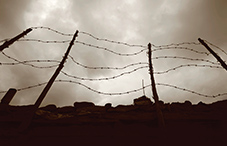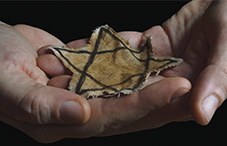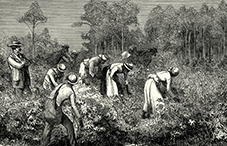By Tori DeAngelis
February 2019, Vol 50, No. 2
Print version: page 36

In the mid- to late 2000s, Brent Bezo and his wife were living in Ukraine, when Bezo began noticing a kind of social hostility and mistrust among the population. It was subtle, “not necessarily something you’d pick up on if you’d spent only a short time there,” says Bezo, a doctoral psychology student at Carleton University in Ottawa.
In his conversations with people, Bezo heard references to the Holodomor, the mass starvation of millions of Soviet Ukrainians from 1932 to 1933, considered by many to be an intentional genocide orchestrated by Joseph Stalin’s regime.
Wondering if and how this horrific event continued to resonate with the people, Bezo conducted a qualitative pilot study of 45 people from three generations of 15 Ukrainian families: those who had lived through the Holodomor, their children and their grandchildren. People spontaneously shared what they saw as transgenerational impacts from that time, including risky health behaviors, anxiety and shame, food hoarding, overeating, authoritarian parenting styles, high emotional neediness on the part of parents and low community trust and cohesiveness—what many described as living in “survival mode” (Social Science & Medicine, Vol. 134, 2015).
“Each generation seemed to kind of learn from the previous one, with survivors telling children, ‘Don’t trust others, don’t trust the world,’” says Bezo. He is now conducting a larger quantitative study to compare intergenerational effects among Ukrainians who remained in the country after the Holodomor, those who emigrated and a group of Ukrainians unaffected by the event. The work is part of an emerging line of research and clinical work in psychology and related disciplines that is exploring whether and how mass cultural and historical traumas affect future generations. Bezo’s observations are compatible with those of researchers who are exploring the intergenerational effects of the Holocaust, the Khmer Rouge killings in Cambodia, the Rwandan genocide, the displacement of American Indians and the enslavement of African-Americans. The transgenerational effects are not only psychological, but familial, social, cultural, neurobiological and possibly even genetic as well, the researchers say.
But except for studies related mainly to the Holocaust, the field is still relatively young and has many unknowns. While trauma researchers have made great strides in understanding and treating single-episode present-life trauma, they are just beginning to explore the impact of intergenerational trauma and its expression, says APA Div. 56 (Trauma Psychology) President Diane Castillo, PhD, a former Texas A&M University associate professor of psychology who has studied and treated combat-related post-traumatic stress disorder (PTSD) for 30 years. The study of PTSD could benefit from the wider lens of an intergenerational perspective, she says, while the study of intergenerational trauma could learn from the systematic work that’s been done on PTSD.

Continuing to explore intergenerational effects can help the field better understand and treat psychological pain at its roots, adds Yael Danieli, PhD, co-founder and director of the Group Project for Holocaust Survivors and Their Children in New York, where she has been a senior psychotherapist since the 1970s.
“Massive traumas like these affect people and societies in multidimensional ways,” says Danieli, who is also the founder of the International Center for the Study, Prevention and Treatment of Multigenerational Legacies of Trauma. “It behooves us to study this area as widely as possible, so we can learn from people’s suffering and how to prevent it for future generations.”
A wider lens on symptoms
One of the first articles to note the presence of intergenerational trauma appeared in 1966, when Canadian psychiatrist Vivian M. Rakoff, MD, and colleagues documented high rates of psychological distress among children of Holocaust survivors (Canada’s Mental Health, Vol. 14). Since then, researchers have been assessing anxiety, depression and PTSD in trauma survivors and their progeny, with Holocaust survivors and their children the most widely studied and over the longest period of time.
Most of these studies have found atypically high rates of these disorders. However, in some cases they find little or no effect at all. A 2017 review of 20 studies of children of cultural and war trauma survivors by Cindy C. Sangalang, PhD, of California State University, Los Angeles, and Cindy Vang, of Arizona State University, for instance, found eight studies showing negative psychiatric, psychosocial and/or behavioral effects on survivors’ offspring, three showing mixed results and two showing no differences between offspring and controls (Journal of Immigrant Minority Health, Vol. 19, No. 3).
Other researchers are taking a broader view of how survivors and their offspring might be affected. In the early 1980s, Danieli began writing about at least four adaptive styles that she and others observed among Holocaust survivors. Examples include “victim,” people who have difficulty moving on from the original trauma and are emotionally volatile and overprotective, and “numb,” those who are emotionally detached, intolerant of weakness in others and who maintain a “conspiracy of silence” within the family. (Other styles include “fighter” and “those who made it.”)

In clinical, group and community work, Danieli also observed specific behavior patterns among children of Holocaust survivors, including an overly protective stance toward their parents, a high need for control, an obsession with the Holocaust and immature dependency. She called these reactions “reparative adaptational impacts” to highlight the notion that survivors’ progeny use them to try to repair the world for their parents, their grandparents and themselves —largely unconsciously. Her related theory predicts a pathway between the initial trauma, the family’s history and post-trauma sociocultural milieu, the adaptational styles of survivors, and the intensity of their children’s and grandchildren’s reparative reactions to them (American Journal of Orthopsychiatry, Vol. 86, No. 6, 2016).
In 2015, Danieli and colleagues started building an empirical foundation for her theory by creating the Danieli Inventory of Multigenerational Legacies of Trauma (Journal of Psychiatric Research, Vol. 68; American Journal of Ortho-psychiatry, Vol. 85, No. 3), a three-part questionnaire tailored to adult children of Holocaust survivors. It asks the children about their parents’ parenting styles, their upbringing, the effects these influences had on their own lives and about their family history and demographics.
Research is starting to support the theory. In a study reported in Psychological Trauma: Theory, Research, Practice, and Policy (Vol. 9, No. S1, 2017), Danieli, Fran H. Norris, PhD, of Dartmouth College, and Brian Engdahl, PhD, of the University of Minnesota, first gave the Danieli inventory to 484 adult children and grandchildren of Holocaust survivors. Then, they conducted additional clinical interviews with a subsample of 191 of those offspring. Overall, 35 percent of the smaller sample had generalized anxiety disorder, 26 percent had a major depressive episode and 14 percent had PTSD. But when they compared those data with the inventory data, 46 percent of those with high reparative impact scores had a psychiatric diagnosis, compared with only 8 percent of those with low scores. In addition, children whose parents scored higher in “victim” and “numb” styles reported a higher intensity of reparative impacts, the team found.
Researchers studying Native American and Canadian populations are likewise finding broad effects among children and grandchildren of survivors of massive cultural oppression. In a 2014 review paper in Transcultural Psychiatry (Vol. 51, No. 3), psychologist Amy Bombay, PhD, an assistant professor at Dalhousie University in Halifax, Nova Scotia, Canada, and colleagues examined studies looking at intergenerational effects of Indian residential schools, institutions run by the Canadian government from the 1880s until the mid-1990s. Eliminating the “Indian problem” was the aim of the schools, according to original government texts. The schools provided a substandard education and taught native children to be ashamed of their languages, cultural beliefs and traditions.
Two large-scale national surveys included in the review—the First Nations Regional Longitudinal Health Surveyand the Aboriginal Peoples Survey—found that children and in some cases grandchildren of those who attended the schools were more likely to report psychological distress and suicide attempts, to have learning difficulties and problems in school and to contract hepatitis C through drug use than controls whose parents had not attended such schools.
Less directly studied is the multigenerational impact of slavery on African-Americans. But an important line of related research studies the relationship between ongoing racial discrimination and trauma. Monnica Williams, PhD, of the University of Connecticut, who has extensively explored this topic, recently developed a measure to assess anxiety related to racial discrimination. Williams and colleagues found that of 123 African-American students who took the measure, those who reported high rates of perceived discrimination also had higher rates than others of uncontrollable hyperarousal, feelings of alienation, worries about future negative events and perceiving others as dangerous (Psychology of Violence, Vol. 8, No. 6, 2018).
While direct studies on intergenerational effects may be sparse, it’s not difficult to spot such impacts in current generations of African-Americans, adds Alfiee Breland-Noble, PhD, who directs the AAKOMA (African American Knowledge Optimized for Mindfully Healthy Adolescents) Project at Georgetown University and studies mental health disorders and treatments in African-Americans.
A current example, she says, is the dread that many African-American parents face in talking with sons about potential police encounters. “It’s traumatizing for parents and it’s traumatizing for kids,” she says.
The scenario is part of a legacy that she terms “shared stress”—the feeling that you have to manage everything within your own community because you don’t know what you’ll encounter in society at large.

“There is a sense among African-Americans and other marginalized people that our stressors are unique to us and not necessarily shared by people outside our groups,” she explains. “So, we share stories of our lived experiences that help set the stage for how our loved ones encounter the world.” In turn, that can lead to a general distrust of others outside the group—particularly those from historically oppressive groups—along with in-group insularity, she says.
Transmission mechanisms
Psychologists and others are also investigating how traumatic effects may be transmitted across generations. In a qualitative study that echoes Danieli’s findings about the importance of family communication and milieu, Lidewyde H. Berckmoes, PhD, of the Netherlands Institute for the Study of Crime and Law Enforcement in Amsterdam, and colleagues spent five months observing and interviewing 41 mothers who lived through the 1994 Rwandan genocide and their teen children.
The team found direct effects of the genocide, including the ways that mothers communicated with their children about the trauma, such as maintaining silence or expressing hope that such an event would never occur again. The investigators also observed indirect effects, such as how the genocide affected the second generation through changes including heightened poverty, greater family work burden and compromised parenting. Meanwhile, teens discussed how they felt these factors affected their own lives. Many said poverty rendered them unable to attend school and forced them to work harder to help keep the family afloat (Societies, Vol. 7, No. 3, 2017).
Trauma psychologist Elena Cherepanov, PhD, of Cambridge College in Boston, has been examining how survivors’ initial reactions to an event may affect future generations—a topic outlined in her upcoming book, tentatively titled “Understanding the Transgenerational Legacy of Totalitarian Regimes: Paradoxes of Survivorship.” Living under such difficult, oppressive circumstances, she surmises, can lead parents to formulate fear-based “survival messages” that they pass on to their children and grandchildren—ideas like “Don’t ask for help—it’s dangerous.” While the messages may have initially helped people stay alive, in the present they are often irrelevant and may even increase people’s interpersonal vulnerability. Fear of personal disclosure and not trusting mental health care providers, for example, “is exactly why it is so hard for trauma survivors to seek and accept support,” says Cherepanov, who is comparing these messages in Russian and American samples.
Still another transmission vehicle may be the body itself. Researchers led by University of California, Los Angeles, economist Dora L. Costa, PhD, examined mortality and other Civil War-era data on 700 Union Army prisoners of war (POWs) and 2,500 of their children, along with data on 5,000 non-POW Union soldiers and 15,000 of their children. Starting from the time the sons of these soldiers turned 45, they found that the sons of Union POWs who had endured particularly harsh conditions while imprisoned died at younger ages overall than the sons of POWs who lived in camps under more favorable conditions or than the sons of non-POW soldiers (Proceedings of the National Academy of Sciences, Vol. 115, No. 44, 2018).
The researchers posit a potential transmission vehicle for these effects: epigenetics, environmentally driven molecular processes that can turn genes on or off. While the researchers’ lack of ability to collect biological samples limited their ability to show a direct association between the earlier deaths and epigenetic changes, in a statistical “process of elimination,” epigenetics emerged as a strong contender.
Taking a more direct look at possible epigenetic transmission is psychologist Rachel Yehuda, PhD, director of the Traumatic Stress Studies Division at the Icahn School of Medicine at Mount Sinai in New York. She and colleagues have found, for example, that children of Holocaust survivors with PTSD have lower rates of methylation—one type of epigenetic mechanism—in a particular stress-related glucocorticoid receptor, the GF-1F, than children of survivors who did not have PTSD (American Journal of Psychiatry, Vol. 171, No. 8, 2014).
More recently, the team has been looking directly at epigenetic changes across generations. In a well-known study comparing methylation rates in 32 Holocaust survivors and 22 of their children with those of matched controls, they found that Holocaust survivors and their children showed changes in the same location of the same gene—the FKBP5, a stress- related gene linked to PTSD and depression—while controls did not (Biological Psychiatry, Vol. 80, No. 5, 2016).
While admittedly small, the study is an important first step, Yehuda and others note, and epigenetics is a fruitful area for further research (World Psychiatry, Vol. 17. No. 3, 2018).
Promising interventions
Despite the many gaps in understanding the transgenerational effects of trauma, clinicians and researchers are delivering interventions based on recent findings, including at the community level.

One example is a long- running intervention being adapted to First Nation and Native American tribes in Canada and the United States called Strengthening Families. Based on a highly successful evidence-based program started at Iowa State University, it aims to prevent early substance use by improving family communication, reducing family conflict and teaching kids substance-use resistance skills. Working closely with the Ojibwe, Lakota, Dakota, Navajo, Pueblo and other tribes, researchers, including sociologist Melissa Walls, PhD, of the University of Minnesota Medical School, are adapting the program to resonate with each tribe.
“We hear a lot about the loss of a sense of community, the loss of generational ties,” says Walls. “It really is a deep hurt, a deep pain—almost a longing for what used to be.” The interventions help to address this chasm by bringing together families and the community as a whole, she says.
Two case studies of working with native groups to adapt the protocol are described in an article by Walls, Jerreed D. Ivanich, a doctoral student at the University of Nebraska–Lincoln, and colleagues (Prevention Science, online first publication, 2018). One version, called Bii-Zin-Da-De-Dah, Ojibwe for “listening to one another,” has been revised over the years to include more culturally relevant material and to be tailored for young children. A fourth iteration of the program is now being tested in a five-year randomized controlled trial funded by the National Institute on Drug Abuse.
The results of these programs can be profound, says Walls, who describes a ceremony held at the end of each intervention. There, parents or caregivers give youngsters a blanket to symbolize their support of the next generation. “It’s always powerful,” says Walls. “It’s a lot more than just a program, I think, for the people who get to do it.”
In the clinical realm, Danieli recommends using her inventory to formulate questions and help treat clients. She also suggests that clinicians work with patients to construct multigenerational family trees that include details of a family’s trauma history—an activity that can help families move beyond secrets and toward connection and growth.
In a similar vein, Cherepanov suggests the use of a “survival genogram,” which adapts the genogram methodology—a pictorial version of a family tree used in psychotherapy to highlight family relationship, health and psychological patterns—to the transgenerational trauma experience. The methodology helps children and grandchildren of survivors to explore ancestral life lessons like “Never let your guard down” in their original context and to examine how such messages can help and hurt them in their present lives (The Journal of Psychodrama, Sociometry, and Group Psychotherapy, Vol. 63. No. 1, 2015).
Meanwhile, Breland-Noble encourages her African-American clients to use a few simple tools to address angry, overwhelmed or numb reactions to historical or present-day race-related injuries. One is simply to name the problem. “We’re so used to living with racially oriented worry and fear that we don’t necessarily recognize or name it as problematic,” she says. “I want people to feel comfortable owning and naming our history.”
She also encourages clients to embrace self-care practices, such as mindfulness, exercise or other nurturing activities. A third tool she emphasizes is prevention—reducing exposure to potential triggers such as news about race-based police shootings or other provocative race-related items.
Addressing present-day traumas like racism that relate to the original trauma is key to helping new generations heal and move on, agrees Bombay. Parents can help, she adds, by using the right communication tools.
“It’s about finding an age-appropriate balance that provides children with the context of the original trauma,” she says, “while at the same time providing them with cultural pride and coping strategies to deal with racism if they encounter it.”
Resources
Cultural Trauma and Epigenetic Inheritance
Lehrner, A., & Yehuda, R., Development and Psychopathology, 2018
International Center for the Study, Prevention and Treatment of Multigenerational Legacies of Trauma
Yael Danieli, PhD, at yaeld@aol.com
International Handbook of Multigenerational Legacies of Trauma
Danieli, Y. Springer, 1998
Intergenerational Perceptions of Mass Trauma’s Impact on Physical Health and Well-Being
Bezo, B., & Maggi, S., Psychological Trauma: Theory, Research, Practice, and Policy, 2018




